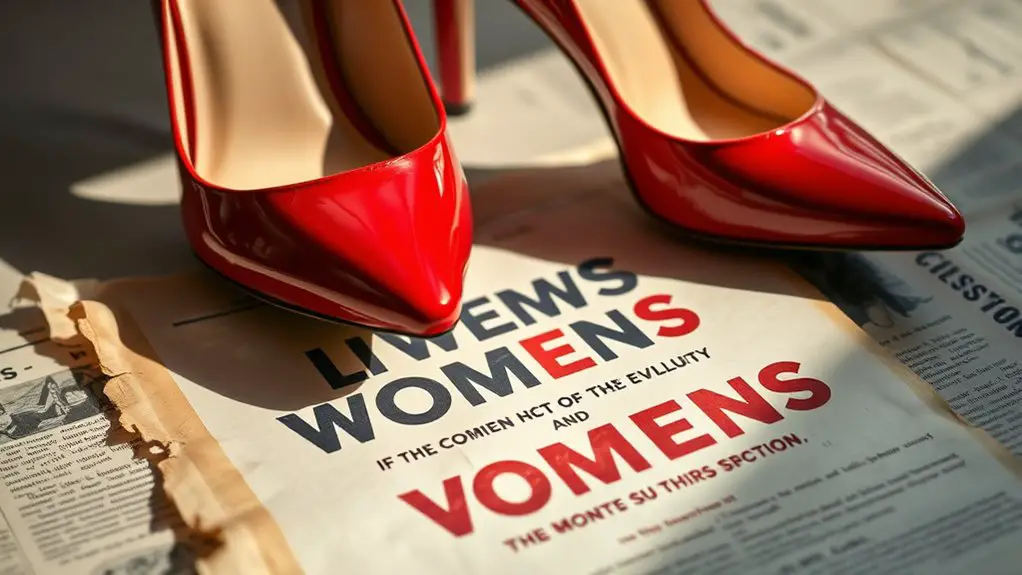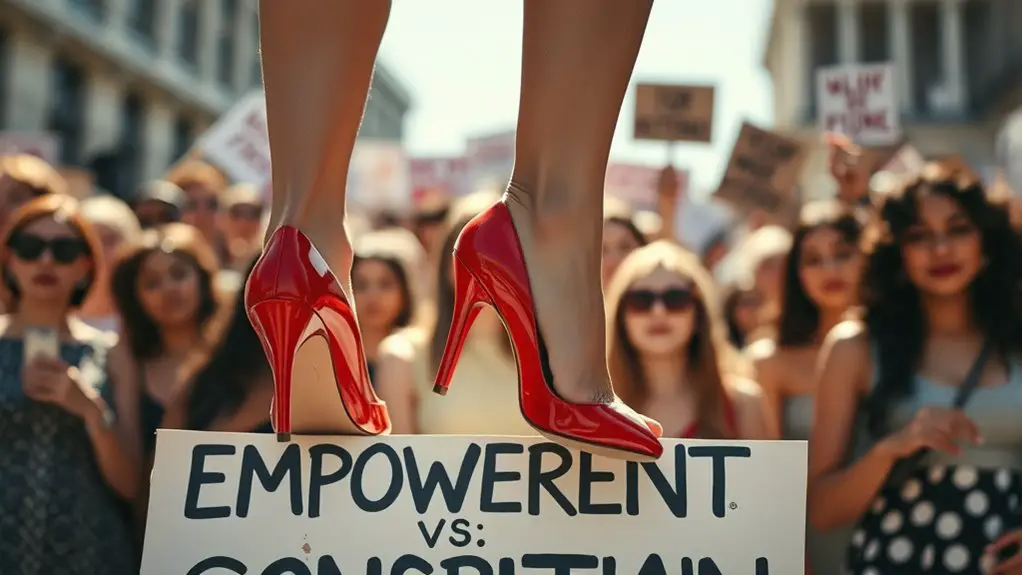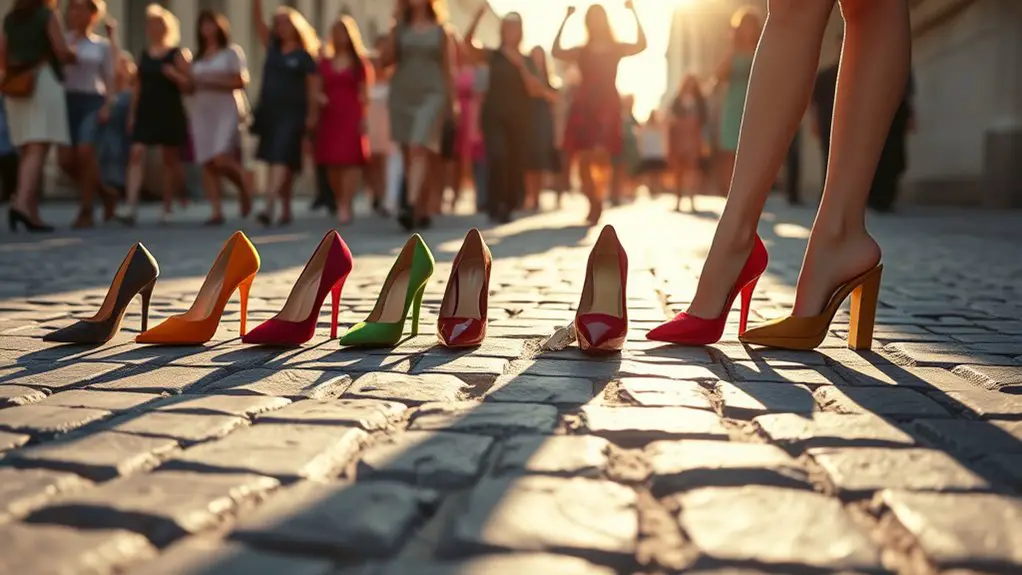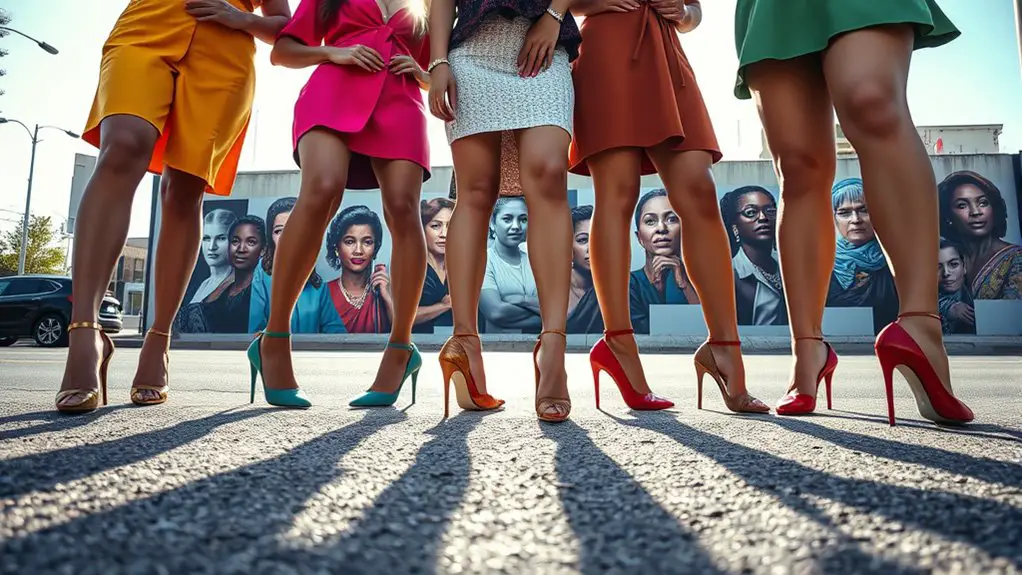High heels have a complex impact on women’s liberation movements. While they can symbolize empowerment and femininity, they often perpetuate societal constraints and unrealistic beauty standards. You feel the duality: high heels can boost confidence while compromising comfort, especially in the workplace. Embracing or rejecting them acts as a personal political statement, challenging traditional norms. As discussions about comfort and agency evolve, the future of high heels reveals deeper truths about gender equality and personal choice. What comes next could surprise you.
The Historical Roots of High Heels

Although high heels are often seen as a symbol of femininity and allure, their historical roots reveal a more complex narrative intertwined with power and social status. You might be surprised to learn that these iconic shoes date back to the 10th century, originally worn by Persian cavalry to secure their feet while riding. As high heels evolved, they became a status symbol among European aristocracy, reflecting wealth and influence. Their historical significance lies in how they transcended mere fashion, acting as a tool for women to navigate social hierarchies. Over centuries, high heels adapted to cultural shifts, mirroring societal attitudes toward gender and class. This cultural evolution illustrates how high heels have been both embraced and critiqued, sparking conversations about identity and empowerment. Consequently, understanding their roots can challenge the perception of high heels solely as objects of desire, revealing deeper implications of societal constructs.
High Heels as Symbols of Femininity
High heels have long been entrenched in the cultural narrative of femininity, serving as more than just a fashion statement. They embody a complex interplay of feminine identity and societal expectations, often dictating how women are perceived and how they perceive themselves. When you slip on a pair of high heels, you’re not just elevating your height; you’re stepping into a role defined by cultural significance, where grace and allure are paramount.
Yet, while heels can enhance your confidence, they also underscore the narrow beauty standards imposed on women. This duality forces you to navigate a tightrope between embracing your feminine identity and challenging the constraints that come with it. In a world that often equates femininity with fragility, high heels become both an emblem of empowerment and a reminder of the limitations placed on women. Consequently, they remain a potent symbol in the ongoing dialogue about femininity and choice.
The Dual Nature of Empowerment and Constraint

While slipping into a pair of high heels might evoke a sense of empowerment, it’s crucial to recognize that this empowerment comes with inherent constraints. This empowerment paradox reflects societal expectations that often prioritize style over comfort, pushing women into a narrow definition of beauty. Historically, high heels symbolize gender roles designed to enhance femininity, yet they can also restrict mobility and self-expression. In the fashion industry, these shoes have become a battleground for body image; wearing them can signify adherence to cultural perceptions of attractiveness. While they allow for individual expression, they simultaneously enforce a rigid standard that can feel oppressive. Ultimately, choosing to wear high heels is a personal choice, but it’s important to understand the dual nature of this choice—one that can both empower and constrain, revealing the complexities of maneuvering contemporary femininity in a world laden with expectations.
High Heels in the Workplace: A Double-Edged Sword
When you step into the office wearing high heels, you might feel a surge of professionalism, but at what cost to your comfort? The pressure to conform to gender expectations can turn what’s meant to boost confidence into a source of pain, both physically and mentally. It raises an essential question: are you truly empowered by your choice, or are you simply adhering to a longstanding societal mandate?
Professionalism vs. Comfort
Although the allure of high heels is often tied to perceptions of professionalism and authority, their role in the workplace reveals a complex dichotomy between style and comfort. You may feel pressured to conform to certain style choices that signal competence, yet these same choices can compromise your work-life balance. High heels can enhance your professional image, but they often come at the expense of physical comfort and well-being. This tension forces you to navigate a landscape where looking polished clashes with the need for practicality. Ultimately, the question becomes whether the pursuit of a polished appearance is worth the discomfort it brings, as you weigh the impact of your footwear on both your performance and personal satisfaction in the workplace.
Gender Expectations and Pressure
As societal expectations evolve, the pressure to wear high heels in professional settings remains a potent symbol of gender norms that dictate how women should present themselves. This expectation isn’t just a fashion choice; it’s a reflection of ingrained gender roles that perpetuate societal pressure. You may feel that your worth is tied to your appearance, forcing you to navigate a treacherous landscape of expectation and discomfort.
- High heels can enhance perceived professionalism, yet they often compromise comfort and mobility.
- The necessity to conform can lead to internal conflict, undermining self-confidence.
- Rejecting this norm can challenge traditional views, sparking broader discussions about gender equality.
Ultimately, it’s a double-edged sword that demands critical examination.
Cultural Shifts: High Heels and Feminist Movements

You might think high heels are just a fashion statement, but their role in feminist movements reveals a complex relationship between empowerment and societal expectations. These shoes can symbolize femininity and strength, yet they also raise questions about the real meaning of choice in a world that often dictates how women should present themselves. As cultural shifts continue, it’s essential to examine whether high heels truly empower or reinforce outdated norms.
Fashion vs. Feminism
While high heels have often been seen as symbols of female empowerment and allure, their role in the broader context of feminism reveals a complex interplay between fashion and liberation. You might find it intriguing how high heel politics challenge traditional notions of fashion feminism. Are women truly liberated when they conform to such aesthetic pressures?
- High heels can reinforce gender stereotypes, limiting freedom of movement.
- The high heel debate often overshadows more pressing feminist issues.
- Embracing or rejecting high heels becomes a personal political statement.
Navigating this terrain forces you to question societal expectations. Are high heels empowering, or do they serve as shackles disguised as symbols of allure? Your choice reflects not just personal style but also your stance within the feminist discourse.
Empowerment Through Choice
Although high heels have long been associated with both femininity and empowerment, their true impact on women’s liberation movements is nuanced and often contentious. You might see high heels as a form of personal expression, a choice that reflects individual style and self-confidence. In this light, choice advocacy becomes essential; it emphasizes the importance of women deciding for themselves what empowerment looks like. However, this choice isn’t always straightforward. The pressure to conform can undermine the very empowerment these shoes symbolize. When you embrace high heels, are you asserting your identity or succumbing to societal expectations? This tension reveals that empowerment through choice is complex, inviting you to reflect on what truly empowers you as a woman in today’s shifting cultural landscape.
Symbolism of Femininity
High heels have long stood as a potent symbol of femininity, embodying both allure and societal expectation. As you navigate through changing cultural perceptions, consider how high heels shape feminine identity and the messages they convey.
- Empowerment vs. Objectification: They can empower you or reduce you to an object of beauty.
- Cultural Dichotomy: High heels reflect both tradition and rebellion, depending on the context.
- Evolution of Meaning: Their significance has shifted alongside feminist movements, challenging norms.
Ultimately, high heels provoke a complex dialogue about femininity, balancing personal choice and societal pressure. Do they enhance your identity, or do they constrain it? The answer lies in your relationship with them, revealing deeper truths about the nature of womanhood today.
The Rise of Comfort and Functionality
As society increasingly prioritizes comfort and functionality, the traditional image of women in high heels is being challenged and redefined. You’re witnessing a shift toward comfort-driven designs that prioritize well-being without sacrificing style. Functional footwear is emerging as a powerful statement in women’s liberation, allowing you to reclaim autonomy over your choices.
| Emotion | High Heels | Functional Footwear |
|---|---|---|
| Empowerment | Restrictive | Liberating |
| Pain vs. Pleasure | Discomfort | Comfort |
| Self-Expression | Conformity | Individuality |
| Confidence | Anxiety | Assurance |
| Mobility | Limitation | Freedom |
This evolution isn’t just about aesthetics; it’s a radical act of self-definition. By opting for practicality, you’re embracing a new narrative that values your comfort and agency, reshaping societal expectations one step at a time.
Celebrity Influence: High Heels on the Red Carpet
When you watch celebrities strut down the red carpet in towering high heels, it’s easy to see both empowerment and conformity at play. On one hand, these bold fashion choices can symbolize confidence and status; on the other, they may reinforce societal pressures that dictate how women should look. Are these glamorous moments truly liberating, or do they simply perpetuate the very standards that movements endeavor to dismantle?
Red Carpet Trends
While many might view red carpet appearances as mere showcases of fashion, the choice of high heels by celebrities reveals deeper societal implications and pressures. When you see those towering stilettos, it’s not just about aesthetics; it’s a complex interplay of expectation and conformity. High heels on the red carpet act as fashion statements, but they also symbolize a struggle against traditional norms of femininity.
- High heels reinforce societal beauty standards.
- Celebrities often feel obligated to conform to these trends.
- The impact of these choices resonates beyond the event, influencing public perception.
Ultimately, the red carpet serves as a microcosm of broader societal issues, where fashion becomes a battleground for self-expression and societal expectations.
Empowerment vs. Conformity
Though high heels may seem like a mere accessory in the world of celebrity fashion, they embody a tension between empowerment and conformity that shapes public perception of femininity. You might see celebrities strutting down the red carpet, their towering heels exuding confidence and allure. Yet, this empowerment paradox raises questions—are they truly liberated, or simply conforming to societal expectations? High heels can symbolize strength and self-expression, but they also reinforce traditional beauty standards that often limit women. As you analyze this dynamic, consider how the choice to wear heels intertwines with broader movements for gender equality. Are they a badge of empowerment or a tool of conformity? Ultimately, your perspective on this issue may redefine how you view women’s liberation in the modern age.
Challenging Beauty Standards: The Anti-Heel Movement
As society grapples with evolving notions of femininity, the anti-heel movement emerges as a powerful critique of traditional beauty standards that have long dictated women’s choices. This activism champions the idea that beauty should be redefined, emphasizing comfort and authenticity over societal expectations. You might find yourself questioning why high heels, often seen as symbols of femininity, should hold such sway over your personal expression.
- Empowerment through Choice: Advocating for the freedom to choose footwear that aligns with personal comfort rather than societal pressure.
- Redefining Beauty: Challenging the narrow definitions of beauty that prioritize aesthetics over well-being.
- Community and Solidarity: Building a movement that supports women in rejecting harmful beauty norms together.
In embracing anti-heel activism, you’re not just rejecting a shoe; you’re participating in a broader conversation about how beauty standards can evolve for the better.
High Heels and Sexuality: A Complex Relationship
High heels have long been intertwined with concepts of sexuality, creating a complex dynamic that influences how women perceive themselves and how society perceives them. You might find that wearing high heels can evoke feelings of empowerment, yet it often walks a fine line with sexual objectification. Societal expectations push these fashion choices as symbols of femininity, impacting your body image and personal identity. Cultural perceptions can either reinforce or challenge this narrative, leading to a feminist critique that questions whether these empowering narratives truly liberate or further entrap women in a cycle of desirability. While some embrace heels as a statement of strength, others see them as a tool of compliance to traditional beauty standards. This duality forces you to navigate a landscape where high heels signify both personal empowerment and societal constraint, complicating the relationship between sexuality and self-expression.
Future Trends: High Heels in the Context of Gender Equality
The evolving narrative around high heels is increasingly influenced by the broader discourse on gender equality, reflecting a shift in how society views women’s roles and choices. As you consider the future of high heels, it’s clear that fashion’s trajectory is entwined with the principles of sustainability and inclusivity.
- A rise in gender-neutral footwear options could redefine what high heels symbolize, prioritizing comfort over convention.
- Brands are beginning to embrace sustainable materials and ethical production methods, responding to consumers’ growing demand for responsible fashion.
- The conversation surrounding high heels may evolve from a symbol of oppression to one of empowerment, where women can choose their footwear based on personal preference, not societal expectations.
As we push for gender equality, the future of high heels may very well hinge on their ability to adapt, reflecting values that resonate with a more progressive society.
Frequently Asked Questions
How Do High Heels Affect Women’s Physical Health Over Time?
Wearing high heels can seriously compromise your foot health over time. The long-term effects include chronic pain, misalignment, and even arthritis, forcing you to reconsider the balance between style and your body’s well-being.
What Are the Most Popular Brands Associated With High Heels?
When choosing high heels, you’re often drawn to designer brands like Christian Louboutin, Jimmy Choo, and Manolo Blahnik. These luxury footwear options not only elevate your style but also symbolize status and sophistication in contemporary fashion.
How Do Men Perceive Women Wearing High Heels?
When you wear high heels, men may perceive femininity as a sign of confidence or adherence to societal expectations. This duality can provoke admiration or critique, revealing deeper complexities in gender dynamics and cultural norms.
Are There Any Famous Protests Against High Heels?
You might find high heel protests intriguing, as they embody feminist symbolism. By challenging societal norms, these demonstrations critique the pressure on women to conform, sparking conversations about empowerment and choice in fashion.
How Do Cultural Attitudes Towards High Heels Vary Globally?
Cultural perceptions of high heels shift dramatically across the globe. In some regions, they’re symbols of empowerment and fashion, while in others, they reflect conformity and oppression. These global trends reveal deeper societal values and norms at play.



